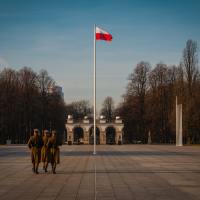
José Manuel Barroso, President of the European Commission, Antonio Tajani, Vice-President of the EC in charge of Industry and Entrepreneurship, and Michel Barnier, Member of the EC in charge of Internal Market and Services, participated in the High-level conference on the future of the European Security and Defence sector. Dimitris Avramopoulos, Greek Minister for National Defence and President in office of the Council of the EU, was also present. (in the first row of seats, from left to right) Philip Dunne, British Minister for Defence Equipment, Support and Technology, with responsibility for Defence Procurement and Defence Exports, Antonio Tajani, José Manuel Barroso and Dimitris Avramopoulos. (EC Audiovisual Services, 04/03/2014).
Today Eurostat, the EU statistical service, published its second and more accurate estimate for the euro area and the EU28 Gross National Product during the last quarter of 2013, and confirmed its flash estimate of 14 February when it had reported GDP increases of 0.3% and 0.4% respectively, in relation to the previous quarter. On a yearly basis though Eurostat found that for the whole year 2013, GDP fell by 0.5% in the euro area and rose by 0.1% in the EU28.
It has to be reminded that the Eurozone marked a first GDP increase of 0.3% during the second quarter of last year, after persistent losses during four consecutive years. In the third quarter of 2013 GDP grew by a mere 0.1%. Now Eurostat confirms a GDP increase by 0.3% in the last three month period of last year. No question then why the resumption of economic activities in Europe is termed as anemic. The EU statistical service also stated that “Compared with the same quarter of the previous year, seasonally adjusted GDP rose by 0.5% in the euro area and by 1.1% in the EU28 in the fourth quarter of 2013, after -0.3% and +0.2% respectively in the previous quarter”.
Of course, there are large differences between member states. Greece, Cyprus (-1.0%), Denmark (-0.5%), Finland (-0.3%) and Estonia (-0.1%) continued losing ground towards the end of last year, while other countries kept growing (Sweden +1.7%, the Czech Republic +1.6%, Romania +1.5%, Lithuania and Slovenia both +1.2%).
Exorcising consumption
It’s very interesting to follow the sectorial analysis of growth. The same source states that, “During the fourth quarter of 2013, household final consumption expenditure rose by 0.1% in the euro area and by 0.2% in the EU28 (after +0.1% and +0.3% respectively in the previous quarter). Gross fixed capital formation increased by 1.1% in the euro area and by 1.4% in the EU28 (after +0.6% and +0.7%). Exports rose by 1.2% in the euro area and by 1.1% in the EU28 (after 0.0% and -0.1%). Imports increased by 0.4% in the euro area and by 0.2% in the EU28 (after +1.0% and +1.1%)”.
It becomes clear that household consumption growth remains at close to zero levels. Given that internal consumption is by far the largest component of GDP, it represents the strongest growth engine for any developed economy. Consumption covers around three quarters of the GDP. Without a strong upwards impetus in this bulk internal driver, overall growth cannot assume a sustainable and strong level. This is the main reason that Eurozone is still considered a stagnating economic area.
Exporting recession
Coming to investments (fixed capital formation) and exports, they appear as the only supports of the Eurozone for a long time. However, investments cannot resume their role as a strong growth driver, because the business sector receives negative or stagnation signals from consumption. This is a strong handicap not only for the consumer goods industry but also for investment goods producers. If the consumer goods sector avoids increasing its productive dynamic, there is no demand for investment equipment.
This leaves Eurozone depending on the exports sector for a growth support. However the developing world, a very important customer for European exports, is now facing mounting financial difficulties with the famous American monetary policy tapering and the reversal of quantitative easing. In the foreseeable future countries and regions and like South America, South Africa, Turkey, Indonesia, India and even China will cut down on imports..
Germany holds back growth
On top of that, developed counties like the US and Canada, massive customers of European products, are progressively raising the tone of complains about Eurozone ‘stealing’ their growth potential, through exports. The idea is that Eurozone’s huge and increasing foreign trade surpluses constitute a threat to its trading partners, because its internal restrictive economic policies are targeted against imports. For example, Germany’s trading partners are not expecting anything positive from this country, because all its economic policies are shaped to support exports and restrain imports. Germany even avoids supporting investments and holds back the liberalization of its internal markets, in order to restrict the activities of foreign players on its soil.
All that means Eurozone cannot continue counting on exports to support its anemic growth. Without a strong push to consumption Eurozone will continue to constitute the ‘black hole’ of the developed world. The US seems increasingly worried about all that and the free trade agreement, currently under negotiations between the EU and the US, is already behind schedule. This strong push to internal consumption and consequently to imports can only be realized if Germany changes course and starts favoring wage increases, less restrictive fiscal rules and a more relaxed monetary policy by the ECB.
As long as those measures remain in the drawer away from table’s top, Eurozone growth will continue to oscillate above and below the zero line. However, the problems in the developing world and the dissent with the US will make it increasingly difficult for Germany and the Eurozone to export its recession to the trading partners.



















amazing and well presented, greetings peace be with you 🙂